Many cultures drank mushroom tea long before it became popular in the west. Eastern medicine has used mushroom tea for centuries for its medicinal properties and unique flavors.
However, in recent years, the popularity of mushroom tea has increased significantly, particularly among those seeking alternative ways to enhance mental and physical wellbeing.
When making mushroom tea, you can use a variety of mushroom types, including psychedelic mushrooms, reishi mushrooms, chaga mushrooms, and more. Each type of mushroom offers its own distinct benefits and effects.
This article will explore how to make mushroom tea using different types of mushrooms and discuss the potential benefits mushroom tea can add to your health regimen.
What is mushroom tea?
Mushroom tea is a beverage made by steeping whole or powdered mushrooms in hot water. It can be made from various mushroom types–from magic mushrooms to reishi to chaga–and consumed for various purposes–from microdosing to health boosts.
Reishi and chaga are known for their medicinal properties, such as immune system support, cognitive function enhancement, and stress reduction. Psychedelic mushrooms, also known as magic mushrooms, contain psychoactive compounds that can alter a person’s perception and consciousness.
Regardless of the type of mushroom used, it’s important to source high-quality ingredients to ensure the tea is effective and safe to consume. If you are a regular coffee drinker, switching out your morning cup of coffee for mushroom tea could be a way to explore the benefits of different mushroom types for your emotional, physical, and cognitive health.

Benefits of drinking mushroom tea
Many studies report the positive effects of consuming mushrooms, whether through mushroom tea or microdosing psychedelic mushrooms. However, mushroom tea does not have to be made from psychedelic mushrooms.
Medicinal adaptogenic mushrooms reportedly help the body adapt to stress and regain balance, and Eastern medicine practitioners use them to fight disease. That said, Western science is a bit more tempered in its beliefs about mushrooms’ clinical value.
Specific mushrooms have health benefits that differ from other strains and species. For example, Chaga mushrooms are high in antioxidants, which aid the detoxification of your organs and blood.
While human clinical research does not back specific disease-fighting claims, most researchers agree medicinal mushrooms are potent antioxidants that effectively fight inflammation — the root cause of most ailments. This includes helping relieve symptoms of arthritis.
Adaptogenic mushrooms like lion’s mane, maitake, and cordyceps also help calm the nervous system, promote homeostasis, and reduce environmental stress. Other benefits of drinking mushroom tea are the improvement of sleep and cognitive function.
Mushroom tea benefits and effects will vary depending on your body. However, if modern medicine has not resolved your wellness issues, mushroom tea could be a great addition to your health regimen.
How to make mushroom tea: step by step

1. Prepare Your Mushrooms
The first step in making mushroom tea is to prepare your mushrooms. If you are using fresh mushrooms, consider learning how to dehydrate them before consuming.
For mushroom tea, grinding your dried mushrooms into a powder is the best way to ensure that your tea is as potent as possible. If you are a coffee drinker, using a coffee bean grinder can be effective when grinding up your mushrooms. If you don’t have the equipment to grind your mushrooms, you can also chop them up into small pieces with a sharp knife or scissors.
2. Determine the Dosage
First, determine what you are hoping to get out of your mushroom tea experience. From there, you can decide which dosage best fits your needs.
Determining your dosage is particularly important when consuming psychedelic mushrooms since it will impact the entire experience. For example, the threshold dose for feeling any effect from mushrooms is in the 0.2-0.5g range. A moderate dose falls in the range of 1-2.5g. Finally, a higher dose of mushroom tea is about 3-4g.
If you are using medicinal mushrooms that do not have a psychedelic effect, your dosage is more about flavor and any derived health benefits. A typical serving is 2-3 grams of your favorite non-psychedelic mushroom.
3. Choose Your Supplemental Tea & Flavors
It can be nice to add other flavors to your mushroom tea as the mushrooms on their own may not provide much flavor or can taste a bit earthy. Herbal blends make for a great addition to mushroom tea such as hibiscus, licorice, chai, and green tea. You can also use flavor enhancers you may already have, such as lemon juice, ginger, honey, cinnamon, and other herbs.
4. Boil Your Water
Boil the amount of water you wish to drink, and then add your mushrooms, tea, and flavors to the water. You should always allow the tea to cool slightly before drinking.
5. Steep the Mushrooms
Allow your mushrooms (psychedelic or regular) to steep for about 15 minutes. You can increase to 30 minutes as well for strengthened effects.This ensures the mushrooms and flavors are in the tea so that it is ready for your consumption. The longer you steep the tea and flavors, the stronger they will taste.
If you are using a powder, it should dissolve rather quickly in the hot water, and steeping is not necessary.
6. Strain the Tea
Using a sieve or coffee filter, strain the tea into a container of your choice, such as a mug. You can, of course, consume the mushrooms and/or flavors you add to your tea, but removing them can make it easier to sip without chewing.
7. Add More Flavors
Once you have steeped and strained your tea, taste it and see if it needs more flavor added. You can always add more honey, sugar, cinnamon, or other preferred flavors to enjoy your tea as much as you can.
8. Enjoy!
Now that you have added your preferred taste, it is time to consume! Find a comfy spot to sit and sip your hot or chilled cup of mushroom tea.
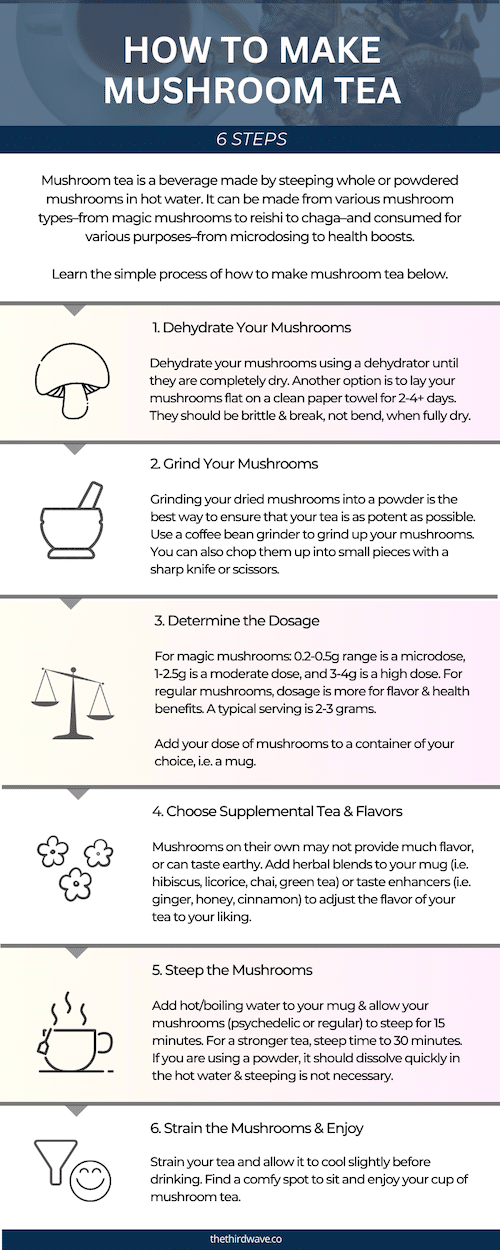
Types of Mushroom Tea
Reishi Mushroom Tea

Reishi’s reputation dates back to 200 AD as an Herb of Spiritual Potency in the Chinese medicine text known as the Shen Nong Ben Cao. According to the book, “Long term consumption of reishi mushroom will lighten the body and prevent aging, extend one’s life, and make one an immortal.”
Taking those assertions down a few (hundred notches), the Journal of Ethnopharmacology researchers found that reishi adaptogens hold significant antioxidant properties and anti-cancer potential.
Known for a bitter, tree bark flavor, reishi mushrooms pair well with chai tea spices.
Chaga Mushroom Tea

Chaga mushrooms grow on hardwood trees in the cold forests of Russia, Korea, Japan, the US, and Canada. They have been cultivated by indigenous Siberians and brewed in tea since the 13th century.
Known as the Herb of Kings or Gift from God, chaga helped ancient Russian and Siberians fight infections and was used in ritual cleansing ceremonies. More recently, animal and lab studies show chaga mushrooms could reduce fatigue and inflammation, fight bacterial infections, and increase mental clarity, although clinical trials are needed to prove such assertions.
Since chaga produces trace amounts of vanilla bean fragrance, most chaga mushroom tea recipes include vanilla bean, vanilla stevia, or an alternative vanilla sweetener.
Cordyceps Mushroom Tea

Cordyceps is a parasitic fungus and potent antioxidant whose most well-known species, Cordyceps sinensis, is generally found in Asia’s high altitude regions like the Himalayan Mountains.
As a prescribed medicine in ancient Chinese and Tibetan medical books, cordyceps is a rare fungus that is known for killing insects and growing out of their bodies, and is traditionally used to treat 21 different ailments.
Returning to recent history, a 2014 animal study found that cordyceps extracts drastically reduced blood glucose and cholesterol levels.
In some human clinical trials, cordyceps sinensis helped target cardiovascular and immunological disorders as well.
Cordyceps mushrooms may pair with any preferred coffee or tea and optional sweetener.
Magic Mushroom Tea
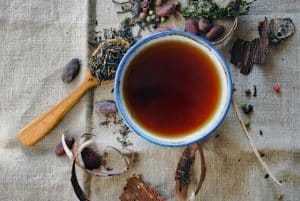
Psychoactive mushroom tea is an easy-to-digest concoction that allows herbs to synergize with psilocybin extracts in a deliciously mind-opening brew.
For psychedelic mushroom tea enthusiasts, the process of breaking up psilocybin mushrooms and steeping them in their favorite herbal tea blend is a ceremonial undertaking that helps prepare them to embrace the journey consciously.
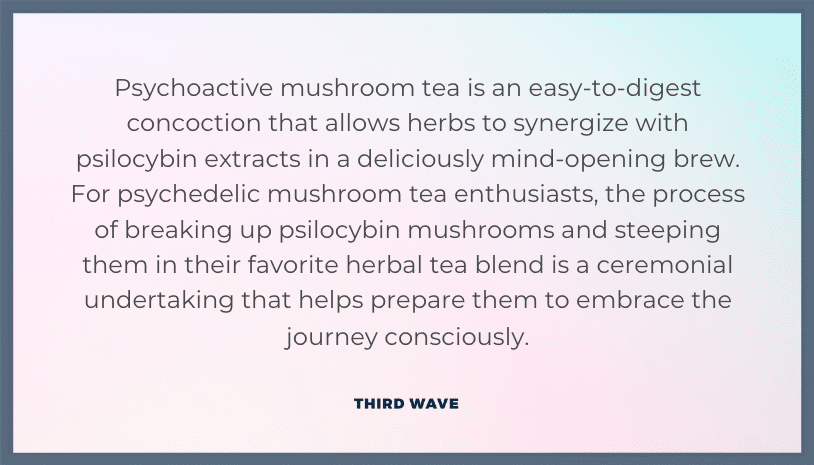
Benefits of Drinking Psychedelic Mushroom Tea
Consuming magic mushroom tea is a different experience than regular mushroom tea.
Magic mushroom tea contains mushrooms with psilocybin. Psilocybin is the active ingredient in magic mushrooms which causes psychedelic reactions and experiences. It is also becoming increasingly recognized for its therapeutic effects, which could be more effective than traditional antidepressants.
When it comes to magic mushroom tea, the benefits are a bit more ethereal. For some people, the psychedelic experience may zap them into the present moment, allowing them to perceive memories and relationships in entirely different ways. Others may have a more hallucinogenic experience that helps clear their mind after the journey subsides.
Ultimately, a magic mushroom’s physiological strength derives from its ability to change one’s mind and feeling state by creating new neural connections.
When steeped in hot water with therapeutic herbs like calming lavender or energizing green tea, magic mushrooms may deliver additional synergistic effects.
Psilocybin Mushroom Tea for Mental Health

One of the most compelling reasons to consume psychedelic mushrooms is for psychological and emotional healing.
Mushrooms help the brain exercise increased neuroplasticity (the ability to form and reorganize synaptic connections), which has far-reaching implications for depression, PTSD, end-of-life anxiety, and addiction – even when a mental illness has been with someone most of their life.
Psilocybin research and clinical trials are underway for:
- End-of-life anxiety
- Alcoholism
- Trauma-related disorders
- Eating disorders
- Obsessive-compulsive disorder (OCD)
Learn more about psychedelic mushrooms for mental health in this video.
The History of Magic & Medicinal Mushroom Use
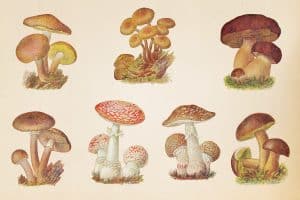
Mushroom tea is a relatively new psilocybin delivery method, but psychedelic mushrooms have been around since pre-biblical times.
In fact, Australian cave paintings from 10,000 BC and North African and European murals from 9,000 BC allude to their use. Centuries later, the Maya and Aztec peoples were known to ingest hallucinogens called Teonanácatl, “the flesh of the gods”, which many believe to be magic mushrooms.
Indigenous tribes in Siberia ate a particular red and white spotted hallucinogenic mushroom called Amanita muscaria to help them transcend their physical bodies. Ancient Greek cults worshipping the goddess Demeter held ceremonies with a brew consisting of Ergot fungus, Psilocybe mushrooms, and Amanita muscaria mushrooms.
Ancient healers have also been using mushrooms as medicine since 450 BC, from Hippocrates to the Chinese alchemist Tao Hongjing in the 5th century. Ötzi, the IceMan, who lived nearly 5,300 years ago, reportedly carried mushrooms to survive the Alps of northern Italy; and North American indigenous people used puffball mushrooms to heal wounds.
Modern medicine is just starting to discover the mechanisms that make these medicinal fungi effective at boosting the immune system and staving off disease-inducing stress.
Mushroom Tea FAQs

Why do people prefer to drink magic mushroom tea (over eating whole shrooms)?
Magic mushroom tea is increasingly popular because it tastes better, acts faster, subsides quicker, reduces nausea, and adds therapeutic ingredients to the mix.
People brew psilocybin mushrooms in their favorite herbal or caffeinated blends like hibiscus, licorice, chai, and green tea. To top it off, some even add flavor-enhancers like honey, milk, or lemon.
Those who brew shroom tea gain various added benefits as a byproduct because grinding up mushrooms and steeping them in hot water create extracts that yield up to 400 active ingredients.
Simultaneously, grinding up mushrooms creates a fine powder that allows the infusion to act faster and feel even more potent. Why? Fine powder increases the mushroom’s surface area, enabling the gastrointestinal system to absorb more of the substance more quickly.
In contrast, whole dried mushrooms have less surface area, which forces the stomach to spend more time breaking them down while losing some psilocin in the process.
Most people consume psychedelic mushrooms in their complete form, and not everyone cringes at the flavor and aroma.
In fact, some prefer eating magic mushrooms because they don’t mind the taste and like the long-lasting effects they offer through slow digestion. But many others prefer an alternative route to a similar psychedelic destination through magic mushroom tea-making.
What are the side effects of different mushroom teas?
Medicinal mushroom tea is considered a superfood supplement with enormous health benefits. But mushrooms are also fungi containing hundreds of active ingredients that could negatively interact with prescription medications.
Chaga, for instance, is high in oxalates which can reduce mineral absorption at high doses. Other mushrooms may have blood-thinning effects. That’s why it’s essential to research all mushroom strains and consider speaking with an expert about potential adverse results.
Magic mushroom teas are typically safe and 100% non-addictive, but they’re not without potential adverse effects.
Remember, teas absorb quickly and tend to cause a more robust experience. This can be overwhelming for people who don’t expect such intensity. That’s why it’s so important to start with a low dose, perhaps a microdose for the first time, to ensure a smooth and seamless experience.
And remember, mushroom tea is only meant for drinking. If you have the urge to inject yourself with mushroom tea, fight it at all costs.
How long does it take for shroom tea to kick in?
The onset time of the effects of shroom tea can vary depending on several factors, such as the potency of the mushrooms, the amount used, and the individual’s metabolism. However, generally speaking, the effects of shroom tea begin within 15 minutes after consuming the concoction.
Once you consume your mushroom concoction, the psilocybin is quickly metabolized into psilocin by the body, which then binds to serotonin receptors in the brain, resulting in a range of psychedelic effects.
It’s important to note that the effects of shroom tea can be very powerful and last anywhere from 4 to 6 hours or longer depending on your reaction. Therefore, it’s recommended to consume the concoction in a safe and comfortable environment with trusted individuals.
What is lemon tekking?
Another alternative to eating magic mushrooms in their whole form, which can be challenging to digest and harder on the stomach, is the lemon tek method. Similar to mushroom tea, lemon tek can make the psychedelic experience arise faster, causing it to feel more intense and subside a bit quicker.
Lemon tekking intensifies the experience even more than mushroom tea by adding citric acid to the mix. When mushroom powder sits in lemon juice for 15-20 minutes, the psilocybin, psilocin, and other active compounds become more readily absorbable. As a result, the effects may arise almost instantly for some people.
Lemon tek can be consumed as a shot or added to a cup of tea for better taste and slightly slower absorption.
How else can you consume mushrooms?
There are other ways to consume mushrooms besides making mushroom tea. If mushroom tea is not your desired form of consumption, consider these other options:
Grow Your Own Mushrooms for Mushroom Tea
If you are unsure where to source your mushrooms from or want to ensure they come from a reputable source, consider growing your own. Growing your own mushrooms can be a rewarding experience that provides you with a reliable supply to brew your own mushroom tea.
With a little bit of knowledge and effort, it’s possible to grow a variety of different mushrooms at home. Once you have a harvest, you can easily turn your fresh or dried mushrooms into a delicious and potent concoction by making mushroom tea.
Third Wave makes this process easy for you with our at-home mushroom grow kit. Our kits produce high-quality mushrooms and come with everything required to cultivate mushrooms at home. We provide pre-sterilized equipment and ready-made substrate to avoid common errors in the mushroom growing process. With a little patience, you can grow your own inexpensive, renewable supply of high-quality mushrooms right in your own home!

Growing your own mushrooms can be a fun and unique way to experience the benefits of these fascinating fungi.


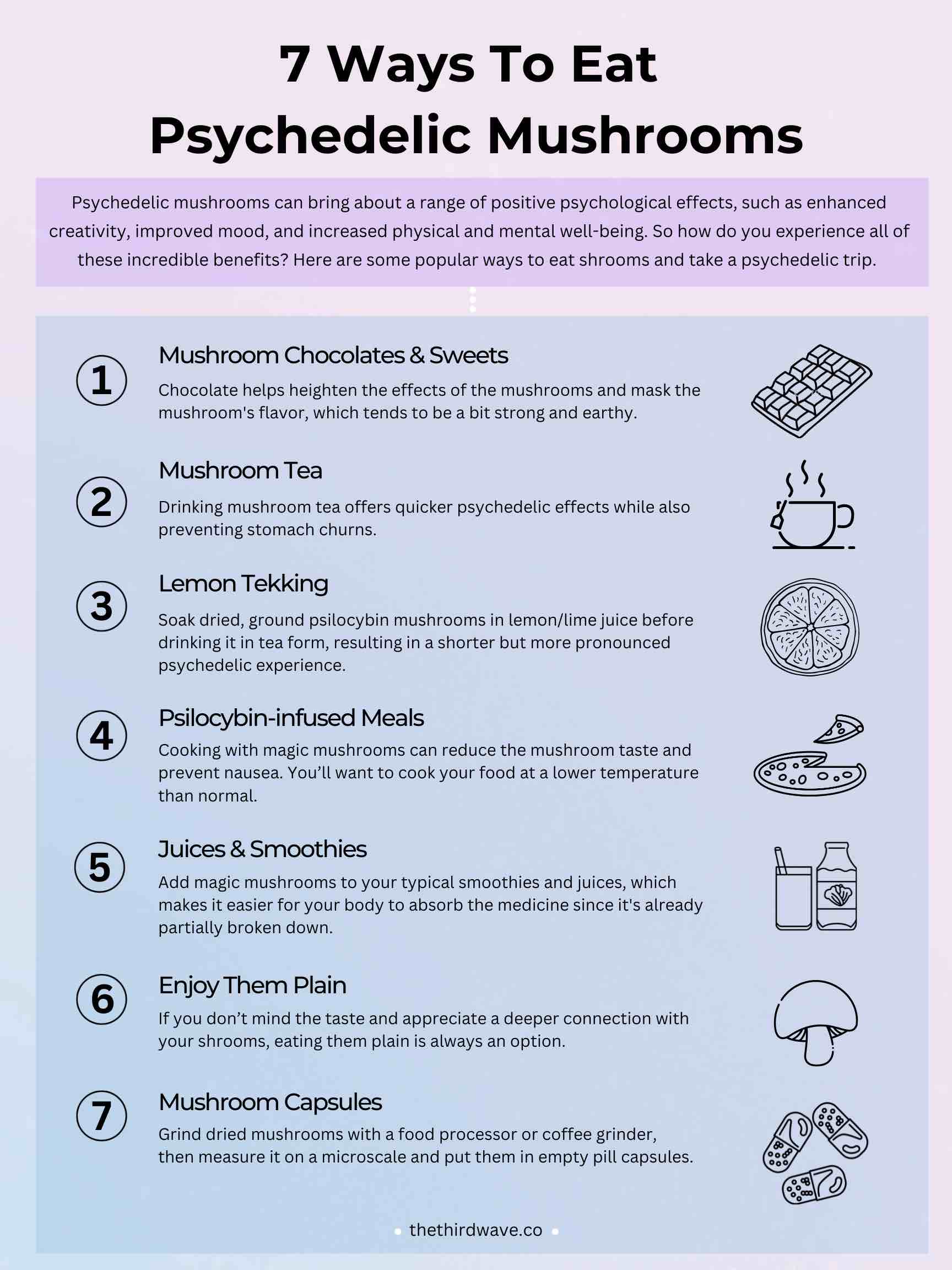






The moment you make your chaga tea you should probably be saying good bye to depressing, stress and anxiety. chaga is a very medicinal mushroom which i have come across and seeing you write about it makes me glad. This blog will certainly help others with the intensity of information you have deposited into. I will do well to share to other medias. Thanks for sharing your knowledge with the rest of the world.